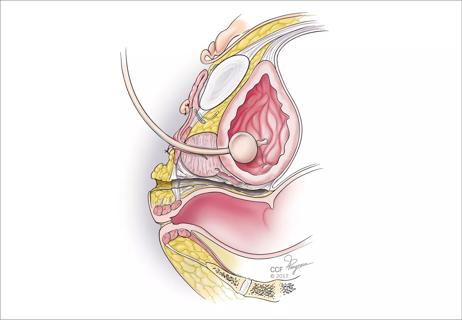Ongoing studies help advance treatments, predictive testing

Cleveland Clinic is a non-profit academic medical center. Advertising on our site helps support our mission. We do not endorse non-Cleveland Clinic products or services. Policy
Despite better cytoreductive surgery and dose-dense and intraperitoneal chemotherapy regimens that have improved overall outcomes for ovarian cancer patients, epithelial ovarian cancer remains the most lethal gynecologic cancer in the United States. Most ovarian cancers are diagnosed at an advanced stage because we lack effective screening.
Poly ADP-ribose polymerase (PARP) is a family of proteins involved in repairing single-strand DNA breaks. PARP1 accounts for more than 90 percent of cellular DNA repair activity.
A class of drugs known as PARP inhibitors has been used as maintenance therapy after response to platinum-based regimens or monotherapy for recurrent ovarian cancer patients since 2014, when they were approved by the Food and Drug Administration (FDA) and the European Medicines Agency (EMA). These drugs – olaparib, rucaparib, veliparib, niraparib and talazoparib – are generally well tolerated with the most common side effects being anemia, fatigue, nausea/vomiting and diarrhea.
Fifteen to 24 percent of ovarian cancer patients have a hereditary form of the disease that affects the homologous recombination (HR) pathway, the most reliable and important of six DNA repair pathways. The tumor suppressor genes BRCA1 and BRCA2 account for approximately 75 percent of these germline alterations. Somatic BRCA1/2 mutations have been reported in 6 percent of cases. Because ovarian cancer patients with BRCA mutations are HR pathway deficient, they are more sensitive to PARP inhibitors.
Olaparib is the first PARP inhibitor studied extensively for patients with recurrent ovarian cancer with germline BRCA mutations who received three or more prior lines of chemotherapy.
A recent phase II clinical trial investigating maintenance olaparib vs. placebo in recurrent platinum-sensitive ovarian cancer after response to platinum-based chemotherapy showed significant improvement in progression-free survival (PFS) in the olaparib arm compared to the placebo arm. PFS and overall survival benefits were more prominent in patients with a germline BRCA mutation.
The EMA has also approved olaparib as maintenance treatment for patients with relapsed BRCA-mutated, high-grade serous ovarian cancer who have responded to platinum-based chemotherapy. Olaparib is now the subject of two phase III trials (SOLO I and II).
Niraparib is a selective PARP1 and PARP2 inhibitor. In the recent phase III NOVA trial, patients with recurrent platinum-sensitive ovarian cancer who responded to platinum-based chemotherapy were randomized to either maintenance niraparib or placebo. Patients who received niraparib had improved PFS compared to placebo. This benefit was more prominent in patients with germline BRCA mutation and in those with high HR deficiency scores. Niraparib is approved as a maintenance therapy in patients with recurrent ovarian cancer who responded to platinum-based therapy regardless of their BRCA status.
Rucaparib is a third selective PARP1 and PARP2 inhibitor recently FDA approved for patients with recurrent ovarian cancer with germline or somatic BRCA mutation after two or more lines of prior chemotherapy. ARIEL II and III trials are phase II and III trials investigating the role of rucaparib in recurrent ovarian cancer.
Two genomic tests have been developed to predict response to PARP inhibitors among patients without germline or somatic BRCA mutations. One measures genomic instability based on three independent tests of tumor tissue. A high score was shown to predict response to niraparib in the phase III NOVA trial.
A second test combines the status of somatic BRCA mutations and the percentage of genomewide loss of heterozygocity to define three subgroups that correlate with response to rucaparib in the ARIEL II trial.
Cleveland Clinic Ob/Gyn & Women’s Health Institute is participating in several phase III clinical trials of PARP inhibitors. One is investigating veliparib as chemotherapy and maintenance therapy (GOG-3005). Another is examining niraparib as maintenance therapy (GOG-3012) in patients with newly diagnosed, advanced-stage ovarian cancer undergoing primary therapy.
Several other trials are investigating the role of olaparib alone or in combination with the oral antiangiogenic drug cediranib, compared to traditional chemotherapy in patients with recurrent platinum-sensitive (NRG-GY004) and platinum-resistant (NRG-GY005) ovarian cancers.
The data are promising regarding PARP inhibitors, especially in recurrent ovarian cancer, and we are awaiting results of current trials in patients with newly diagnosed ovarian cancer as part of primary therapy.

Deprivation is linked to impaired glucose intolerance and racial disparities

Artesunate ointment is safe well and tolerated patients with vulvar intraepithelial neoplasia

A case-based discussion of efficacy, eligibility and use

Workshop curriculum was valued by some, while others would have preferred time for themselves

Study finds lower incidence of endometriosis than in cisgender patients

Large randomized study compares embryo growth kinetics and live birth rates between culture media

Surgeon experience is key to reducing adverse events

Introducing Laura Detti, MD, newly appointed Chair of the Department of Subspecialty Care for Women’s Health